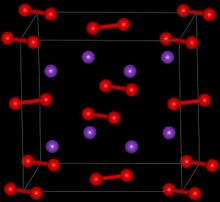Potassium peroxide
Topic: Chemistry
 From HandWiki - Reading time: 3 min
From HandWiki - Reading time: 3 min

| |
| Names | |
|---|---|
| IUPAC name
Potassium peroxide
| |
| Identifiers | |
3D model (JSmol)
|
|
| ChemSpider | |
| EC Number |
|
PubChem CID
|
|
| UNII | |
| |
| |
| Properties | |
| K2O2 | |
| Molar mass | 110.196 g/mol |
| Appearance | yellow amorphous solid |
| Melting point | 490 °C (914 °F; 763 K) |
| reacts with water[1] | |
| Structure | |
| Orthorhombic | |
| Cmca, oS16 | |
| Thermochemistry | |
Std molar
entropy (S |
113 J·mol−1·K−1[2] |
Std enthalpy of
formation (ΔfH⦵298) |
−496 kJ·mol−1[2] |
| Hazards | |
| GHS pictograms |  
|
| GHS Signal word | Danger |
| H272, H315, H319 | |
| P210, P220, P221, P264, P280, P302+352, P305+351+338, P321, P332+313, P337+313, P362, P370+378, P501 | |
| NFPA 704 (fire diamond) | |
| Related compounds | |
Other anions
|
Potassium chloride |
Other cations
|
Lithium peroxide Sodium peroxide Rubidium peroxide Caesium peroxide |
| Potassium oxide Potassium superoxide Potassium ozonide | |
Except where otherwise noted, data are given for materials in their standard state (at 25 °C [77 °F], 100 kPa). | |
| Infobox references | |
Potassium peroxide is an inorganic compound with the molecular formula K2O2. It is formed as potassium reacts with oxygen in the air, along with potassium oxide (K2O) and potassium superoxide (KO2).
Potassium peroxide reacts with water to form potassium hydroxide and oxygen:
- [math]\ce{ 2K2O2 + 2H2O -> 4KOH + O2 (^) }[/math]
Properties
Potassium peroxide is a highly reactive, oxidizing white to yellowish solid which, while not flammable itself, reacts violently with flammable materials. It decomposes violently on contact with water. [1]
The standard enthalpy of formation of potassium peroxide is ΔH f 0 = −496 kJ/mol.
Usage
Potassium Peroxide is used as an oxidizing agent and bleach (due to the peroxide), and to purify air.
References
- ↑ Lide, David R. (1998). Handbook of Chemistry and Physics (87 ed.). Boca Raton, Florida: CRC Press. pp. 477; 520. ISBN 0-8493-0594-2.
- ↑ 2.0 2.1 Zumdahl, Steven S. (2009). Chemical Principles 6th Ed.. Houghton Mifflin Company. p. A22. ISBN 978-0-618-94690-7.
 |
Licensed under CC BY-SA 3.0 | Source: https://handwiki.org/wiki/Chemistry:Potassium_peroxide10 views | Status: cached on October 06 2024 16:19:56↧ Download this article as ZWI file
 KSF
KSF

